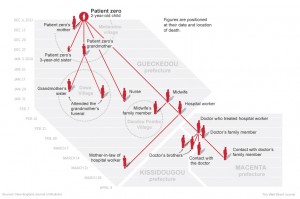The Ebola Outbreak
Concern has been growing about the wide-spread Ebola breakout in West Africa. While small and localized outbreaks are not uncommon, a breakout of this scale and spread rate is alarming. Usually Ebola outbreaks are contained in rural areas, but this one is spreading in urban centers. Ebola is deadly, once the disease is contracted 90% of those infected die. However, the amount of people that one infected person can infect is very low. In order to be infected, a person has to come in very close contact with the bodily fluids of the infected person. This places health workers in the highest field of risk.
This particular outbreak can be traced back to the “patient zero”. In a network graph, the nodes are the infected people and the edges connect them to other nodes that the others have infected. This particular network is useful to tracing the original carrier of the disease and the areas to where the disease has spread. In the figure below, the beginning of the outbreak is outlined showing how “patient zero” is connected to others who contracted Ebola.

http://graphics.wsj.com/ebola-crisis/
For outbreaks in rural regions, health experts use a network of the infected to contain the outbreak. Usually for outbreaks of Ebola, a team goes to the affected area and identifies the cases of those infected, or the “nodes”. They then identify people who might come into contact or who have come into contact with these nodes. These are the possible edges of the graph. Any strong relationships others have with the infected nodes lead to a higher chance of contact, and thus a higher chance of infection. In fact, those with the highest risk are immediate family members of the infected and the caretakers. To prevent these potential edges from forming, the team isolates the original nodes. This method is highly effective in containing the outbreak in rural areas. In urban areas, this is not so effective which is why the current Ebola outbreak is causing so much alarm. The network would be too complicated, which makes it hard to guess possible edges. Even though the network graph may not be useful now with preventing the spread of Ebola, it could be highly effective in the future for studying the the spread of Ebola from region to region.
http://news.nationalgeographic.com/news/2014/07/140728-ebola-americans-nigeria-africa-world-health/?utm_source=Daily+Skimm&utm_campaign=4912cb8e9a-daily_skimm&utm_medium=email&utm_term=0_74efee6205-4912cb8e9a-24536185
